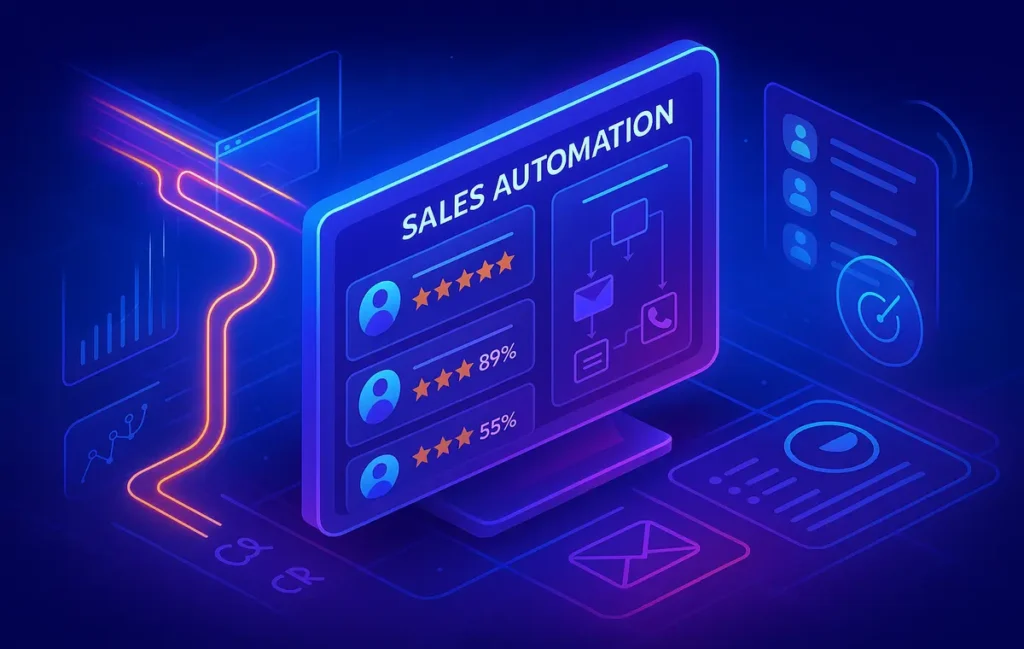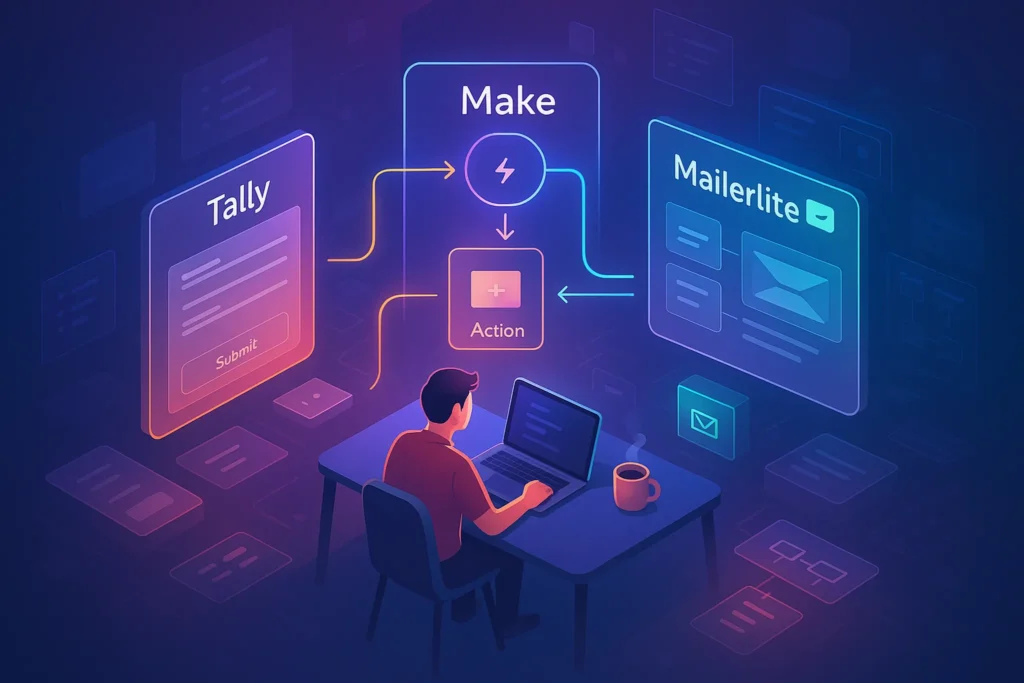🎯 Intro
Finding and qualifying leads manually is a bottleneck that has drained sales teams for years. SDRs spend hours sourcing contacts, verifying emails, and writing outreach messages, only to discover many prospects are irrelevant or unresponsive. In 2025, sales prospecting automation tools are rewriting this playbook. They allow teams to find, enrich, score, and reach out to leads at scale, transforming sales prospecting from a slow manual grind into a streamlined, data-driven engine.
The rise of automation has already reshaped marketing, as seen in topics like Top 10 Automation Tools for Marketers. But for prospecting specifically, the shift is even more urgent—because outbound teams can’t afford to waste time or headcount on repetitive data entry. Instead of SDRs drowning in spreadsheets, automation platforms now deliver qualified, ready-to-engage leads straight into CRMs.
🔍 Why Automate Sales Prospecting?
Manual prospecting is inefficient. A typical SDR might spend 60% of their week on research and admin tasks, leaving limited time for conversations. The cost of acquiring customers rises when headcount scales instead of productivity.
Automation addresses these challenges in three ways. First, it reduces the time burden by outsourcing repetitive research—scraping LinkedIn, gathering firmographic data, verifying emails—into automated workflows. Second, it improves accuracy by pulling in real-time signals such as buying intent and account-level data, ensuring that sales teams target the right prospects. Third, it enables scalability—companies can multiply outbound activity without multiplying staff, a necessity for fast-growing startups and lean SMBs.
This is particularly relevant for businesses using Best Lightweight CRMs for Micro-Businesses, where small teams can’t afford inefficiency. With automation, even solopreneurs can run outbound campaigns that look like enterprise-level operations.
🛠️ Core Features of Prospecting Automation Tools
Prospecting automation isn’t just about finding email addresses—it’s a layered system of features that collectively build efficiency:
-
Lead sourcing. Tools scrape LinkedIn, prospecting databases, and websites to identify decision-makers and contacts.
-
Data enrichment & verification. Emails and phone numbers are validated; additional firmographic data (industry, size, revenue) and intent signals are added to qualify leads.
-
Scoring & qualification. AI models rank leads based on relevance, intent, and likelihood to convert.
-
Outreach automation. Personalized email and LinkedIn sequences are triggered automatically but tailored to each lead segment.
-
CRM integration. Seamless syncing ensures that leads, scores, and engagement history flow into systems like HubSpot or Salesforce.
When layered together, these features give sales teams a 360-degree view of prospects and free them from manual busywork.
💡 Nerd Tip: Combine demographic data with intent signals—like visits to your pricing page—for lead scoring. Teams that use both often see conversion rates 2–3x higher than those relying on demographics alone.
⚡ Best Tools in 2025
By 2025, the automation landscape is crowded, but a handful of platforms stand out:
-
Apollo.io – A full-stack platform for sourcing, enrichment, and automated outreach. It’s favored by fast-scaling startups thanks to its affordability.
-
ZoomInfo + Engage – Enterprise-grade with deep databases, intent data, and multichannel outreach features. Costly, but comprehensive.
-
Clay + AI enrichment – New-generation tools blending enrichment APIs with AI models to auto-generate personalized outreach messages.
-
HubSpot Sales Hub – Combines CRM with prospecting automation, making it ideal for SMBs already invested in HubSpot.
-
Lusha / Clearbit – Data providers with prospecting add-ons, great for firms that need scalable enrichment pipelines.
Teams often mix tools—using Apollo for outreach and Clearbit for enrichment, for example. This flexibility lets sales leaders optimize for both price and performance.
🚀 Workflow Example
A real-world automated prospecting workflow in 2025 might look like this:
-
Extract leads from LinkedIn using a prospecting tool like Apollo or Clay.
-
Enrich the data with email verification, company revenue, tech stack, and buyer intent.
-
Run AI-driven scoring to prioritize high-probability accounts.
-
Push leads into personalized sequences using tools like Outreach or Salesloft, with automated throttling to avoid spam.
-
Sync all activity back to the CRM, ensuring alignment with the broader sales pipeline.
Instead of SDRs spending 20 hours a week on manual research, they now spend that time on actual conversations, demos, and negotiations.
This process resembles how marketers use ClickFunnels vs Alternatives for automation in funnels—but here, it’s applied specifically to the outbound prospecting layer.
⚠️ Challenges & Solutions
Even the best automation tools face challenges. Data quality is a persistent issue; databases decay quickly, leading to bounced emails and wasted effort. The solution is real-time verification and ongoing enrichment.
Another risk is spam perception. Automated sequences can trigger filters or alienate prospects if personalization is weak. Smart teams solve this by blending automation with personalization—using AI to customize opening lines or referencing recent prospect activity.
Finally, compliance can’t be ignored. Regulations like GDPR and CCPA demand that teams respect privacy and consent. Modern tools now prioritize opt-in sources and provide compliance dashboards, but sales leaders must still enforce responsible practices.
📈 ROI of Sales Prospecting Automation
The return on investment is measurable. Companies adopting prospecting automation report:
-
Lower CAC (customer acquisition cost). With SDRs spending more time selling than researching, productivity per rep increases.
-
Higher qualified lead volume. AI scoring ensures that outbound campaigns focus on accounts with genuine buying intent.
-
Scalable growth without headcount creep. Teams can double outbound volume without doubling SDR staff.
For solopreneurs, this ROI is even sharper. As shown in How to Use Niche Automation Tools to Scale as a Solopreneur, a single person can run enterprise-level prospecting campaigns, competing with larger teams.
⚡ Automate Your Pipeline
Stop wasting SDR hours on spreadsheets. Try Apollo, HubSpot Sales Hub, or Lusha free trials and see how automation helps you focus on closing deals—not chasing data.
🔎 1. Advanced Data Sources
Prospecting automation in 2025 goes far beyond LinkedIn scraping. Modern tools tap into intent platforms, technographic data, and even job postings to build richer profiles of potential buyers. For example, if a company is actively hiring for “cloud engineers,” that’s a strong signal they may need DevOps software. If they’ve recently attended an industry event or downloaded a whitepaper, it suggests buying intent.
These advanced signals create a competitive edge. Instead of targeting cold lists, SDRs can focus on accounts already warming up. Some platforms even track content engagement across the web—prospects who read three blog posts about automation are much closer to conversion. By blending firmographics (who they are), technographics (what they use), and intent signals (what they plan to do), automation tools move prospecting from guessing to science.
📊 2. Case Studies with Numbers
Numbers help prove why automation is more than hype. Consider a SaaS startup that adopted Apollo.io for outbound campaigns. Before automation, their SDR team averaged 40 qualified leads per month. After implementing automated sourcing, enrichment, and AI scoring, that number doubled to 85 qualified leads, while SDR headcount remained the same. CAC dropped by 20% within two quarters.
In e-commerce, one brand integrated Clearbit enrichment with Outreach sequences. By layering intent data on top of demographics, their email open rates increased from 18% to 37%, and conversion-to-demo rate improved by 2.4x. These results illustrate that the ROI of prospecting automation isn’t abstract—it’s measurable, and it compounds over time.
🧩 3. AI in Prospecting Outreach
AI has moved from background scoring models to frontline personalization engines. Instead of SDRs writing repetitive outreach lines, tools now generate hyper-personalized messages. For example, an AI tool might scan a prospect’s LinkedIn activity and write: “Saw your recent post about scaling a remote team—our tool helps exactly with that challenge.”
This isn’t generic mail merge—it’s contextual outreach at scale. AI can draft subject lines, adjust tone, and even suggest multi-step sequences that adapt based on prospect behavior. If a lead clicks a pricing page, the next email addresses ROI; if they don’t engage, the sequence shifts tone. This level of automation would have been science fiction five years ago. In 2025, it’s standard.
🏭 4. SMB vs Enterprise Playbooks
Prospecting automation isn’t one-size-fits-all. Small businesses and solopreneurs typically gravitate toward leaner stacks. A combination like Apollo.io + Lusha provides affordable data sourcing and basic outreach automation—perfect for SMBs running agile sales teams. As shown in How to Use Niche Automation Tools to Scale as a Solopreneur, these setups allow even one-person businesses to run enterprise-style prospecting campaigns.
Enterprises, on the other hand, lean on heavyweight platforms like ZoomInfo + Salesloft or HubSpot Sales Hub. These stacks offer richer databases, deeper integrations, and compliance features that SMBs may not need but large firms can’t operate without. The difference isn’t just budget—it’s strategy. SMBs prioritize flexibility and affordability; enterprises prioritize scalability, compliance, and system-wide alignment.
🔮 5. Integration with Marketing Automation
A critical evolution in 2025 is the tighter alignment of sales prospecting with marketing automation systems. It’s no longer enough to send outbound emails in isolation. Instead, prospecting tools now sync with platforms like HubSpot Marketing Hub, Marketo, or Pardot to ensure seamless nurturing.
For example, a lead identified and qualified by Apollo can be automatically enrolled in a marketing drip campaign if they’re not yet sales-ready. Conversely, a lead engaging with a marketing webinar can be pushed into a sales sequence immediately. This sales–marketing handshake reduces friction, prevents lead leakage, and ensures every dollar spent on acquisition is maximized. For teams still comparing CRM vs. Marketing Automation, this integration is a game-changer.
📈 6. Pitfalls & Failure Stories
Automation isn’t a magic bullet. Many teams fall into traps that waste time and harm brand reputation. One common mistake is buying bulk databases. These lists often contain outdated or inaccurate data, leading to bounce rates of 40% or higher. Not only does this hurt deliverability, it damages domain reputation—making all outbound less effective.
Another pitfall is over-reliance on automation with zero personalization. Sending 10,000 identical emails may look efficient, but spam filters will catch up fast. Worse, prospects perceive the brand as careless. In one case, a startup blasted generic AI-written emails, only to find their domain blacklisted within weeks. The lesson is clear: automation amplifies good processes, but it also amplifies bad ones. SDRs must blend automation with thoughtful personalization to succeed.
🛡 7. Future Outlook: Autonomous Sales Agents
Looking ahead, the next frontier is autonomous sales agents. Imagine AI agents that handle the entire chain—sourcing, enrichment, qualification, outreach, and even initial discovery calls. Early experiments already exist, where AI bots schedule meetings on behalf of SDRs.
By 2027, it’s realistic to expect hybrid teams where humans focus on high-stakes conversations, while AI handles the volume-heavy tasks. These agents won’t replace sales teams, but they’ll dramatically reduce the manual workload, freeing reps to focus on strategy and relationship-building.
This trajectory aligns with broader automation trends explored in Top 10 Automation Tools for Marketers. Prospecting automation isn’t just evolving—it’s converging with AI agents to create self-driving pipelines. Teams that prepare now will be better positioned to lead in this new landscape.
📬 Want More Smart Sales & Automation Insights?
Join our free newsletter to get weekly tips on automation tools, AI-driven sales strategies, and no-code workflows—curated by NerdChips for growth-focused teams.
🔐 100% privacy. Just actionable insights. No spam, only value.
🧠 Nerd Verdict
By 2025, prospecting automation has moved from luxury to necessity. Manual lead sourcing and qualification can’t keep pace with fast-moving markets. Teams that embrace automation now will capture market share faster, spend less on acquisition, and free their reps to focus on what matters most—closing deals.
In the evolving sales stack, prospecting automation is the new frontline. Ignore it, and you risk being left behind.
❓ FAQ: Nerds Ask, We Answer
💬 Would You Bite?
Would you rather have your team buried in data entry—or focused on closing the next big deal?
Crafted by NerdChips for teams and solopreneurs who want to automate growth without adding headcount.



